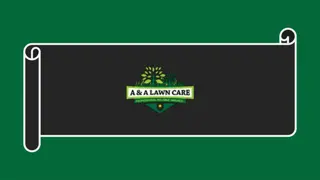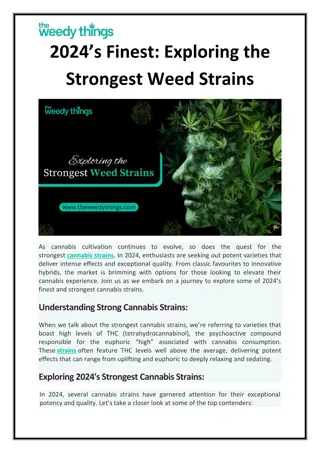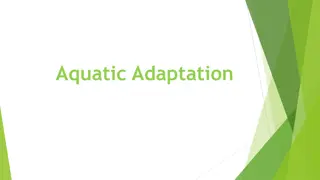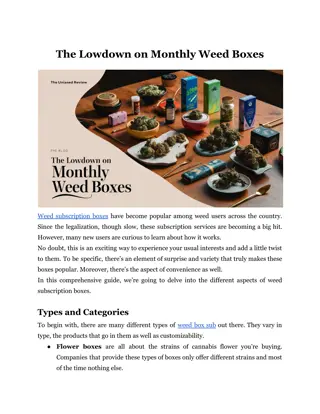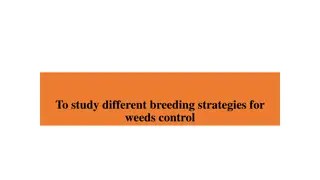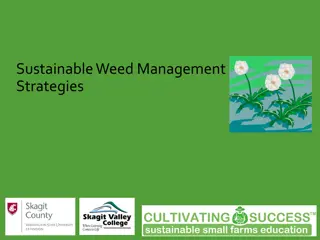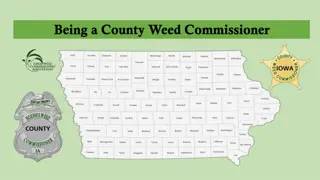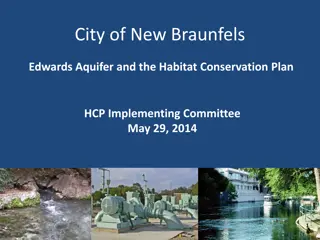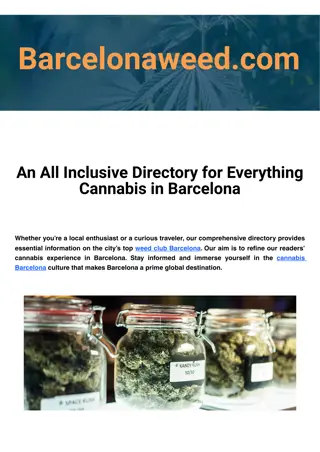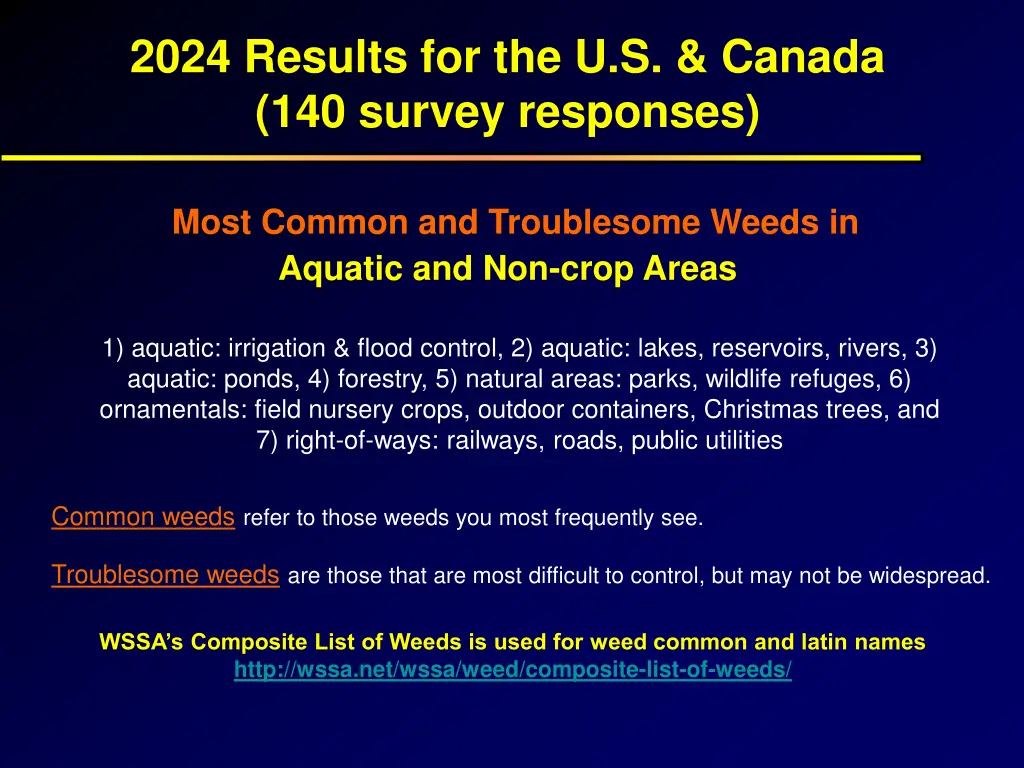
Weed Survey Results for U.S. & Canada: Common and Troublesome Weeds in Aquatic and Non-crop Areas
Explore the findings of a survey conducted across the U.S. and Canada, covering the most common and troublesome weeds in various areas such as irrigation, flood control, lakes, reservoirs, rivers, ponds, forestry, natural areas, ornamentals, and right-of-ways. The survey data provides insights into the top weeds plaguing these environments, shedding light on prevalent species like pondweed, watermilfoil, hydrilla, cattails, and more. View the comprehensive results and understand the challenges posed by these invasive plants.
Download Presentation

Please find below an Image/Link to download the presentation.
The content on the website is provided AS IS for your information and personal use only. It may not be sold, licensed, or shared on other websites without obtaining consent from the author. If you encounter any issues during the download, it is possible that the publisher has removed the file from their server.
You are allowed to download the files provided on this website for personal or commercial use, subject to the condition that they are used lawfully. All files are the property of their respective owners.
The content on the website is provided AS IS for your information and personal use only. It may not be sold, licensed, or shared on other websites without obtaining consent from the author.
E N D
Presentation Transcript
2024 Results for the U.S. & Canada (140 survey responses) Most Common and Troublesome Weeds in Aquatic and Non-crop Areas 1) aquatic: irrigation & flood control, 2) aquatic: lakes, reservoirs, rivers, 3) aquatic: ponds, 4) forestry, 5) natural areas: parks, wildlife refuges, 6) ornamentals: field nursery crops, outdoor containers, Christmas trees, and 7) right-of-ways: railways, roads, public utilities Common weeds refer to those weeds you most frequently see. Troublesome weeds are those that are most difficult to control, but may not be widespread. WSSA s Composite List of Weeds is used for weed common and latin names http://wssa.net/wssa/weed/composite-list-of-weeds/
Survey Data received from 37 States, but no Provinces NO Survey Data from the following states: 1) Connecticut 2) Hawaii 3) Iowa 4) Maine 5) Massachusetts 6) New Hampshire 7) New Jersey 8) New York 9) Pennsylvania 10) Rhode Island 11) Tennessee 12) Vermont 13) West Virginia
Top 4 Weeds in Irrigation and Flood Control (24 survey respondents) MOST COMMON MOST TROUBLESOME 1 pondweed spp. (7) 2 watermilfoil spp. (6) 3 hydrilla (5) T4 Tie among 3 species (4) T1 pondweed spp. (7)* T1 cattail spp. (7)* 3 duckweed (6) 4 common elodea (5) - pondweed spp. included sago, curlyleaf, & horned pondweed - watermilfoil spp. included Eurasian, variable, & parrotfeather watermilfoil - cattail spp. included common cattail ( )* indicates number of survey respondents who listed the weed species as one of their top 5 weeds in this area.
Top 5 Weeds in Lakes, Reservoirs, Rivers (35 survey respondents) MOST COMMON MOST TROUBLESOME T1 watermilfoil spp. (16) T1 hydrilla (16) T3 algae spp. (8) T3 eelgrass spp. (8) T5 Tie between 2 species (7) T1 watermilfoil spp. (16) T1 pondweed spp. (16) 3 hydrilla (11) 4 cattail spp. (10) 5 naiad spp. (9) - watermilfoil spp. included Eurasian, variable, & parrotfeather watermilfoil - pondweed spp. included curlyleaf, sago, Illinois, Richardson s, & whitestem pondweed - algae spp. included cyanobacteria - eelgrass spp. included American, Australian, & a non-native hybrid - naiad spp. included southern, brittleleaf, slender & hollyleaf naiad
Top 2 Weeds in Ponds (3 survey respondents) MOST COMMON MOST TROUBLESOME 1 naiad spp. (3) 2 algae spp. (2) T1 southern naiad (2) T1 algae spp. (2) - naiad spp. included southern & brittleleaf naiad - algae spp. included cyanobacteria
Top 3 Weeds in Forestry (15 survey respondents) MOST COMMON MOST TROUBLESOME T1 T1 T1 1 2 kudzu (4) honeysuckle spp. (4) privet spp. (4) honeysuckle spp. (6) privet spp. (4) Tie among 5 species (3) T3 - honeysuckle spp. included Japanese and Amur honeysuckle.
Top 4 Weeds in Natural Areas: Parks, Refuges (18 survey respondents) MOST COMMON MOST TROUBLESOME T1 T1 T3 Bromus spp. (5) knapweed spp. (5) Tie among 6 species (3) T1 T1 3 4 Bromus spp. (6) Canada thistle (6) Elaegnus spp. (5) Pennisetum spp. (4) - Bromus spp. included cheatgrass, red & smooth brome - knapweed spp. included spotted and diffuse knapweed and yellow starthistle - Elaegnus spp. included Russian & autumn olive - Pennisetum spp. included buffelgrass and crimson fountaingrass
Top 3 Weeds in Ornamentals: Field Nursery Crops, Outdoor Containers, Christmas Trees (7 survey respondents) MOST COMMON MOST TROUBLESOME T1 T1 T1 woodsorrel spp. (3) bittercress spp. (3) spurge spp. (3) 1 spurge spp. (3) Tie among 4 species (2) T2 - woodsorrel spp. included creeping woodsorrel - spurge spp. included spotted and prostrate spurge - bittercress spp. included hairy and flexuous bittercress
Top 5 Weeds in Right-Of-Ways: Railways, Roads, Public Utilities (38 survey respondents) MOST COMMON MOST TROUBLESOME 1 2 1 kochia (16) johnsongrass (15) Canada thistle (8) Amaranthus spp. (8) Salsola spp. (7) johnsongrass (17) Canada thistle (13) kochia (13) Amaranthus spp. (9) Russian thistle (9) T2 T2 T4 T4 T3 T3 5 - Salsola spp. included Russian thistle & common saltwort.






